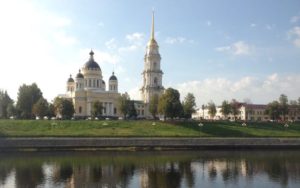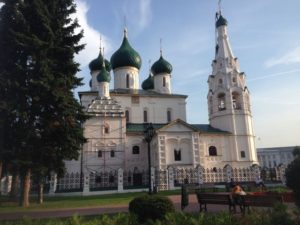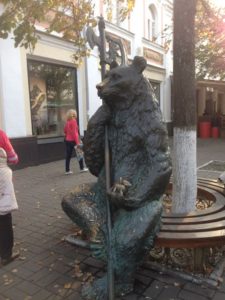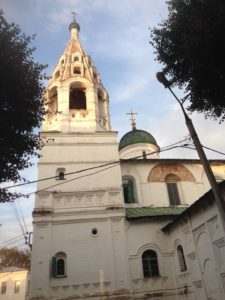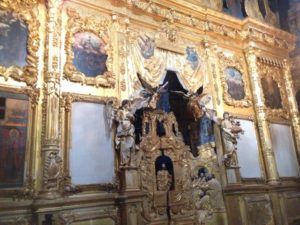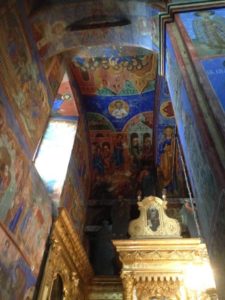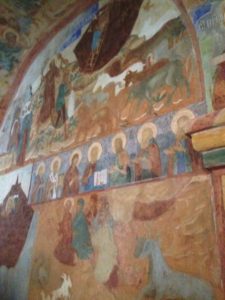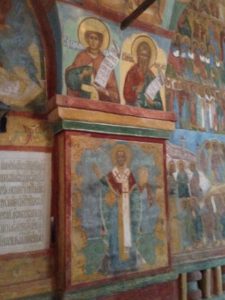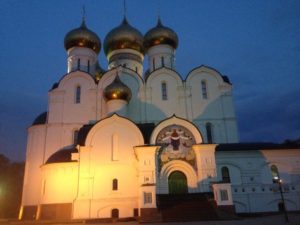We crossed the Rybinsk Reservoir, created by Stalin by damning the Volga and the Sheksna rivers and flooding 700 villages. We entered the Rybinsk Waterway marked by a colossal statue.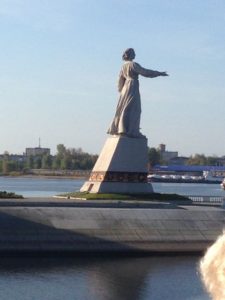
Along the way we saw numerous onion domed churches.
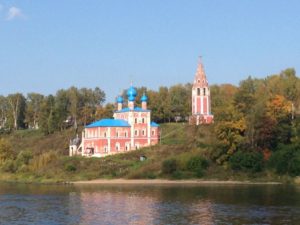 We arrived in Yaroslavl, a city of 650,000 people, located on the confluence of the Volga and the Kotorosl Rivers, at 3:00 p.m. Yaroslavl is a lovely city of classical buildings, parks, pedestrian streets and lovely old churches. It is one of Russia’s oldest cities, tracing its roots back to the days of the Vikings. It was officially founded in 1010 by Prince Yaroslav the Wise and was a major commercial center from the 11th century onward. In 17th century wealthy merchants built 50 cathedrals in the city, a tradition carried on by today’s oligarchs, one of whom just built a new Cathedral of the Assumption decorated with ceramic mosaics 8 years ago, and another of whom built a park with colored fountains at the confluence of the two rivers. Yaroslavl was the home of the first professional theater in 1750. Yaroslavl is also considered an outstanding example of the urban planning Empress Catherine the Great ordered for the whole of Russia in 1763.
We arrived in Yaroslavl, a city of 650,000 people, located on the confluence of the Volga and the Kotorosl Rivers, at 3:00 p.m. Yaroslavl is a lovely city of classical buildings, parks, pedestrian streets and lovely old churches. It is one of Russia’s oldest cities, tracing its roots back to the days of the Vikings. It was officially founded in 1010 by Prince Yaroslav the Wise and was a major commercial center from the 11th century onward. In 17th century wealthy merchants built 50 cathedrals in the city, a tradition carried on by today’s oligarchs, one of whom just built a new Cathedral of the Assumption decorated with ceramic mosaics 8 years ago, and another of whom built a park with colored fountains at the confluence of the two rivers. Yaroslavl was the home of the first professional theater in 1750. Yaroslavl is also considered an outstanding example of the urban planning Empress Catherine the Great ordered for the whole of Russia in 1763.
The Alexander Nevsky Chapel is surrounded by classical buildings.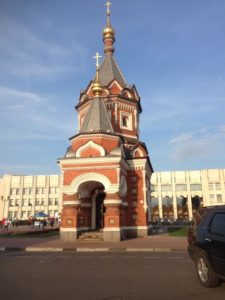
We got to see a couple taking wedding pictures with antique cars.
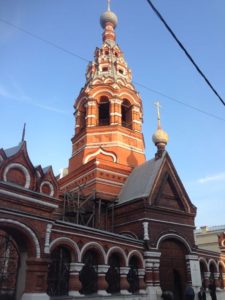 Church of Elijah the Prophet with its detailed frescoes and icons, a real masterpiece of ancient Russian art.
Church of Elijah the Prophet with its detailed frescoes and icons, a real masterpiece of ancient Russian art.
The Church of St. Nicholas was the first stone church in Yaroslavl.
It’s interior is richly decorated with brightly colored frescoes. The ornate altar doors resemble stage curtains, largely because one of Yaroslavl’s professional actors was involved in its design.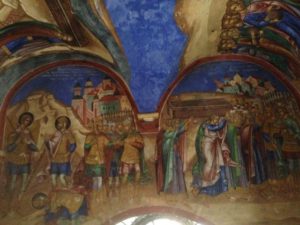
Just two years ago, the 16th century frescos in the antechamber were discovered. They are more muted in color and depict the story of Adam and Eve and of Noah’s Arc.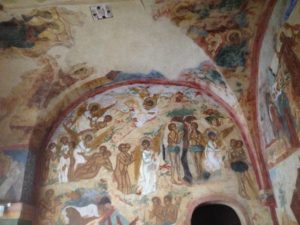
The depiction of the saints is similar to Byzantium style.
The Yaroslavl Museum of Russian Art housed in the 18th century Governor’s mansion. We were given a tour by a costumed daughter of the 18th century governor who explained the collection of Russian paintings and many of the customs of the day. At the end of the tour we were treated to a ball in the ballroom with music and dance demonstrations, which the visitors were welcome to join.
On our way out, we saw a display of laquerware from various provinces.
Afterwards, we walked through a park and saw the eternal flame commemorating soldiers and workers with the brand new Cathedral of the assumption behind it with the moon coming up in the corner. It was a lovely temperate evening, with flocks of starlings in the trees.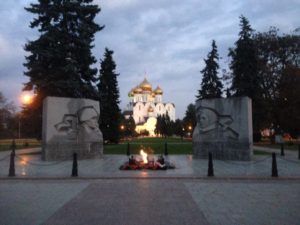
We were also treated to a Russian musician singing in the park.





